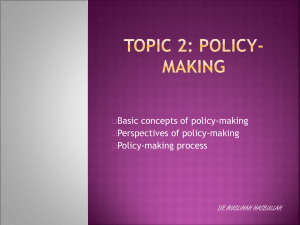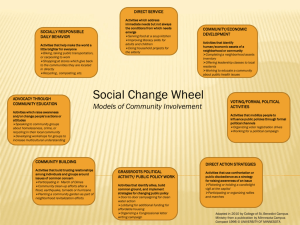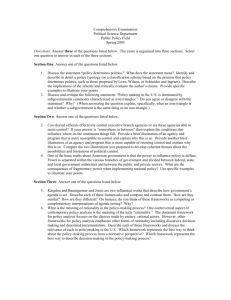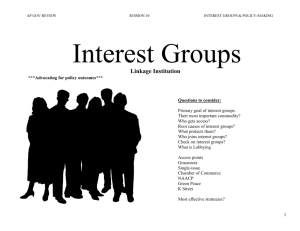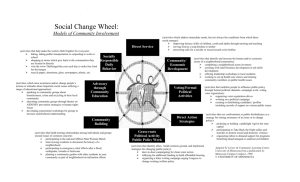ln on policy - Gather the People
advertisement
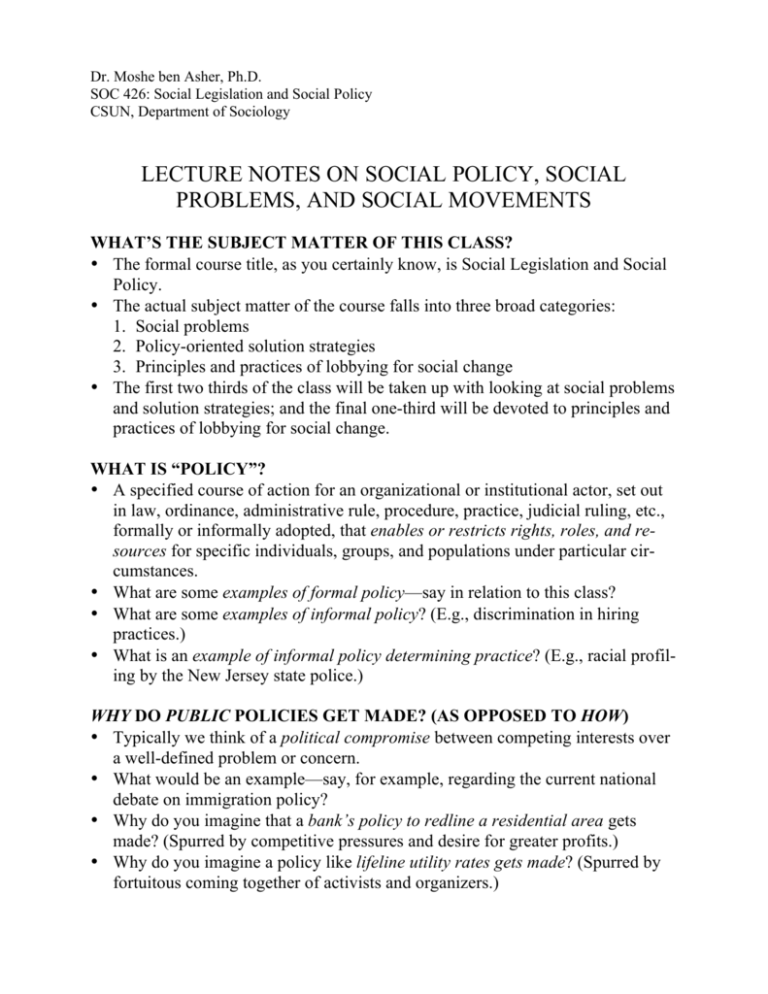
Dr. Moshe ben Asher, Ph.D. SOC 426: Social Legislation and Social Policy CSUN, Department of Sociology LECTURE NOTES ON SOCIAL POLICY, SOCIAL PROBLEMS, AND SOCIAL MOVEMENTS WHAT’S THE SUBJECT MATTER OF THIS CLASS? • The formal course title, as you certainly know, is Social Legislation and Social Policy. • The actual subject matter of the course falls into three broad categories: 1. Social problems 2. Policy-oriented solution strategies 3. Principles and practices of lobbying for social change • The first two thirds of the class will be taken up with looking at social problems and solution strategies; and the final one-third will be devoted to principles and practices of lobbying for social change. WHAT IS “POLICY”? • A specified course of action for an organizational or institutional actor, set out in law, ordinance, administrative rule, procedure, practice, judicial ruling, etc., formally or informally adopted, that enables or restricts rights, roles, and resources for specific individuals, groups, and populations under particular circumstances. • What are some examples of formal policy—say in relation to this class? • What are some examples of informal policy? (E.g., discrimination in hiring practices.) • What is an example of informal policy determining practice? (E.g., racial profiling by the New Jersey state police.) WHY DO PUBLIC POLICIES GET MADE? (AS OPPOSED TO HOW) • Typically we think of a political compromise between competing interests over a well-defined problem or concern. • What would be an example—say, for example, regarding the current national debate on immigration policy? • Why do you imagine that a bank’s policy to redline a residential area gets made? (Spurred by competitive pressures and desire for greater profits.) • Why do you imagine a policy like lifeline utility rates gets made? (Spurred by fortuitous coming together of activists and organizers.) • What about a policy like restrictive deed covenants? (Probably the initial result of profit-driven individual developers, but eventually becoming institutionalized.) WHAT ARE THE BASIC TYPES OF POLICY? • Regulatory policy limits the action(s) of persons or groups to protect the public interest. (For example, consider the recent debate over Oxycontin.) • Distributive policy determines how the income on wealth will be shared with various groups. (This is the arena in which social welfare policy is made.) • Redistributive policy determines redistribution of political or economic resources, i.e., wealth itself rather than the income on wealth. (Examples would be changes in policy of granting FCC licenses, bank charters, or in the formation of public jurisdictions.) • Constitutional—what may be also be called structural or deep policy—affects the basic structures of society, such as those expanding voting rights or eliminating the tax on wealth, and are usually very long-lived. • Policy targeting may also be characterized according to whether it primarily serves a special interest or the commonweal or public interest, and whether it is aimed at achieving equity or equality. WHO ARE THE PRIMARY PLAYERS IN THE POLICY-MAKING PROCESS? • Wealthy individuals (e.g., Bill Gates) • Powerful political advocates (e.g., Senator Diane Feinstein, etc.) • Organized corporate special interest lobbying groups (e.g., oil and gas lobby, pharmaceutical industry lobby, etc.) • Organized, nonprofit public interest lobbying organizations (e.g., Common Cause, Nader organization, etc.) • Organized labor unions and labor federations. • Established, nonprofit special interest national membership organizations (e.g., NRA, AARP, Sierra Club, Greenpeace, etc.) • Challenging nonprofit grassroots organizations, federations, and coalitions (e.g., IAF, PICO, etc.) • Challenging nonprofit Internet-based organizations (e.g., USAction, MoveOn, and ActForChange). WHAT ARE THE LOCAL, REGIONAL, STATEWIDE, AND NATIONAL ARENAS OF POLICY-MAKING THAT WE’RE PRIMARILY INTERESTED IN? 2 • Public: city councils, county boards of supervisors, state legislatures and regulatory bodies (e.g., public utility commissions), and the Congress. • Private profit-making: corporations, business organizations (e.g., chambers of commerce, the Business Roundtable, etc.), and professional organizations (e.g., the AMA, NASW, etc.). • Private nonprofit: foundations, universities, professional associations (lawyers, doctors, etc.). WHO MAY INTRODUCE A POLICY PROPOSAL OR PROPOSED LEGISLATION? • Only a member of Congress or other legislative body may directly introduce legislation. • At the state and local level, however, through the initiative and referendum processes, laws and ordinances may be introduced through petitioning and balloting. • This process may even be used to introduce structural policy, say in the form of creating a new public jurisdiction, such as a city or special district. WHAT ARE THE MAIN VARIABLES IN POLICY-MAKING OUTCOMES? • Power • Public or private interest • Expertise • Publicity WHO ARE THE MAIN EXPERTS IN PUBLIC POLICY-MAKING? • Corporate spokespeople who have massive resources and access to gather and present expert opinion • Corporate lobbyists • Public bureaucrats who have longevity, knowledge, access to officials, legislative mandate, and political savvy • Legislative committees that make critical trade-offs (bargaining and negotiating) and have long-term continuity in the policy-making process • Public interest lobbies, institutes, think-tanks, and research organizations WHAT ARE SOME OF THE THIRD-PARTY ORGANIZATIONS THAT INFLUENCE POLICY-MAKING? • Print press and broadcast media • Regulatory agencies and organizations • Civil and criminal courts • Universities and colleges 3 WHAT ARE THE MAIN THEORETICAL EXPLANATIONS OF THE POLICY-MAKING PROCESS? • Rational problem-solving assumes that policy-making reflects rational assessment of all relevant values, interests, and outcomes for the sake of the general public interest. • Interest group policy-making assumes that policy is the outcome of openly competing pluralistic interests. • Elite-dominated policy-making assumes that a handful of wealthy and powerful individuals are dominating the process. • Incremental policy-making assumes that policy-making is largely an evolutionary process, with each policy reflecting those that came before it. WHAT IS A “SOCIAL PROBLEM”? • One conventional definition is that a social problem exists when there is a sizable gap between social ideals and their actual realization in social life. • So, given that definition, is “racial discrimination” a social problem? 1. Who says so? 2. What makes it a social problem? 3. How can we say that our social ideal is equality if the dominant social forces maintain discrimination on a relatively large scale? 4. What is it that feeds those forces of discrimination? • How does a sociologist reach a definite conclusion on whether or not racial discrimination is a social problem? • In professional community organizing practice, we use three different but related terms to deal with this subject: 1. Social conditions, such as the fact of racial discrimination, regardless of any value judgments about it; 2. Social problems, such as when a group of people determine that a social condition injures them or adversely affects their interests; and 3. Social issues, which emerge when the interests affected by a particular problem motivate different groups to take competing or conflicting positions on a particular problem. WHAT’S THE CONNECTION BETWEEN SOCIAL PROBLEMS AND SOCIAL MOVEMENTS? § What is a social movement? § What’s the difference between an organized social movement and one that’s unorganized? § How does a social movement begin? [PUNISHING CONDITIONS AND PEOPLE TALKING TOGETHER ABOUT THEM] 4 § Suppose you’re one of those thousands of working class people, like household domestics, who has to rely on public transportation in L.A. 1. You live in a low-income neighborhood, far away from the upper-middleincome neighborhood in which you work. 2. You can’t afford a car, insurance, and upkeep. 3. Public transportation is slow, expensive, and not reliable, causing you to suffer both personal and economic hardship. 4. What might that hardship entail? • What’s the obstacle to the emergence of a social movement, which requires that people begin talking about these punishing conditions and identifying them as shared social problems? THE FIRST STEP IN RESOLVING SOCIAL PROBLEMS REQUIRES THE EXISTENCE OF COMMUNITY, OR THE BUILDING OR REBUILDING OF COMMUNITY IF NECESSARY. • What is “community” and why should it be essential to resolving social problems? • What’s the difference between a community and, let’s say, a “population,” an “institution,” an “organization,” or a “group”? • The community structures in which the seeds of the civil rights movement were planted in the South after World War II were: 1. Beauty parlors and barber shops 2. Churches • When I began community organizing in Compton more than 30 years ago, crime there was totally out of control—a very small percentage of individuals were criminally victimizing the large law-abiding majority. 1. The police department was incompetent and corrupt. 2. It has since been disbanded and replaced by a contract with the L.A. County Sheriffs, which apparently has not resolved the social problem of crime in Compton. 3. It was so bad in the early 1980s that many people had stopped reporting crimes and were afraid to leave their homes unattended to go to church. 4. Here’s the interesting piece: When I began organizing in the Compton Gardens neighborhood, I learned two salient facts almost immediately: (a) the neighborhood park had been taken over by gangs many years before, dead bodies were frequently discovered there, and neighborhood residents had not used the park for years; and (b) very few residents knew their neighbors well enough to address them by name, so there was virtually no talk about the problems of gangs and the park. • The point is that nothing could happen to resolve those problems without the existence of community with relationship networks that gave residents the op5 portunity to acknowledge the conditions, reach agreement on which were problems for them, work out their positions on the issues, and formulate plans for taking action together. • So the first step was to bring neighborhood residents together informally to get acquainted, discover their common problems, and identify their common interest in organizing themselves to take action. WHICH BRINGS US TO THE SECOND STEP IN RESOLVING SOCIAL PROBLEMS—BUILDING ORGANIZATIONS. • Why would people in Compton in 1981 need to build neighborhood organizations? • What do you imagine are some of the advantages of formal organizations if a neighborhood wants to deal with a social problem? • Organizations offer opportunities for the development of: 1. Competent and committed leaders 2. Widely shared understandings about conditions, problems, and issues 3. Strategic and tactical plans 4. Disciplined political action 5. Alliances and coalition-building with other organizations • When organizations with common goals and methods begin to ally themselves—whether in the labor movement, the civil rights movement, or a town like Compton—we get the beginnings of organized movement. • In Compton, some dozen neighborhood-organizations came together in a citywide movement to deal with crime. SO LET’S CONSIDER MOVEMENTS IN MORE DETAIL. • What are some movements that we might regard as successful, even if we don’t particularly share their interests or ideologies? 1. American independence in the 18th century 2. Mormons in the 19th century 3. Labor in the 19th and 20th centuries 4. Civil rights in the 20th century 5. Women in the 20th and 21st centuries • What are the benchmarks of their success—why do we regard them as successful? 1. Achieved changes in institutional policies and practices 2. Achieved changes in institutionalized structures 3. Achieved a permanent place at the “table of power” 4. Institutionalized their own resource-acquisition (e.g., through tithes, taxes, payroll-deduction dues, etc.) • But why did they succeed—what were the critical variables in their success? 6 1. Historic punishing conditions that fostered widespread identification with the movement 2. Inspiring moral and strategic vision 3. Commitment to effective leadership development 4. Commitment to building federations, coalitions, and alliances 5. Development of a professional organizing cadre (i.e., trained and full-time working staff) 6. Courage and competence to mount large-scale social and political actions and campaigns that confront and engage in constructive conflict with powerful opponents 7. Persistence born of necessity and insight into incremental character of constructive and durable fundamental social change 7
